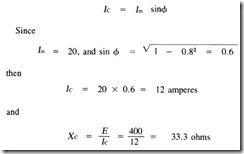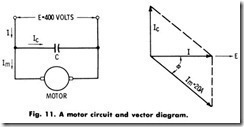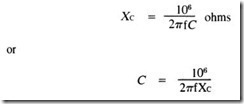Problem-A single-phase motor is taking 20 amperes from a 400- volt, 50-hertz supply, the power factor being 80% lagging. What value of capacitor connected across the circuit will be necessary to raise the power factor to unity?
Solution-With reference to the vector diagram in Fig. 11, it is evident that
The equation for the capacitive reactance is
Inserting values and simplifying
Problem-A 220-volt, 60-hertz, 10-hp, single-phase induction motor operates at an efficiency of 86% and a power factor of 90%. What capacity should be placed in parallel with the motor so that the feeder supplying the motor will operate at unity power factor?
Solution-
The current taken by the motor is
Current taken by the capacitor is
The capacitive reactance of the capacitor is
Capacity necessary is
Problem-In a balanced three-phase, 208-volt circuit, the line current is 100 amperes. The power is measured by the two-wattmeter method; one meter reads 18 k Wand the other zero. What is the power factor of the load? If the power factor were unity and the line current the same, what would each wattmeter read?
Solution-
The expression for power is
Since one wattmeter reads zero, then
With the power factor unity and with the same line current, then
That is, each wattmeter reads 36/2, or 18 kW.
Problem-In a certain manufacturing plant, a single-phase alter nating current of 110 volts, 60 hertz is applied to a parallel circuit having two branches. Branch 1 consumes 27 k W with a lagging power factor of 0.8, while Branch 2 consumes 12 kW with a leading power factor of 0.9. Calculate the
(a) Total power supplied in kW and kVA.
(b) Power factor of the total load.
Solution-
(a) Total power supplied is
The reactive-power component supplied by Branch 1 is
Similarly, the reactive-power component supplied by Branch 2 is
The sum of the reactive-power components is
Total power supplied, in kVA, is
(b) Power factor of the total load is




![Motor-Calculations78_thumb_thumb_thu[1] Motor-Calculations78_thumb_thumb_thu[1]](http://machineryequipmentonline.com/electric-equipment/wp-content/uploads/2020/06/Motor-Calculations78_thumb_thumb_thu1_thumb.jpg)



![Motor-Calculations87_thumb_thumb_thu[2] Motor-Calculations87_thumb_thumb_thu[2]](http://machineryequipmentonline.com/electric-equipment/wp-content/uploads/2020/06/Motor-Calculations87_thumb_thumb_thu2_thumb.jpg)
![Motor-Calculations88_thumb_thumb_thu[2] Motor-Calculations88_thumb_thumb_thu[2]](http://machineryequipmentonline.com/electric-equipment/wp-content/uploads/2020/06/Motor-Calculations88_thumb_thumb_thu2_thumb.jpg)